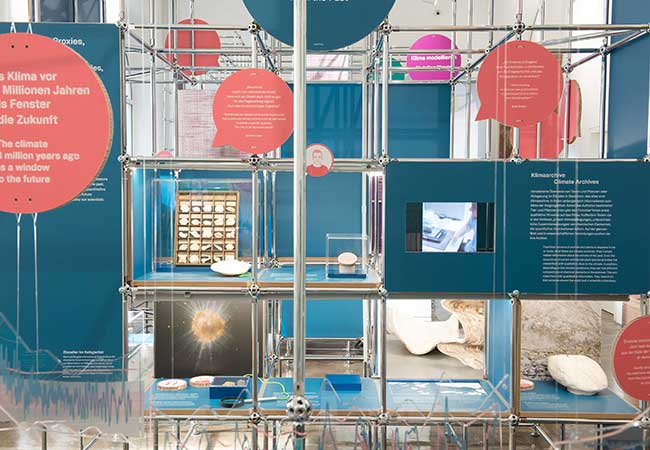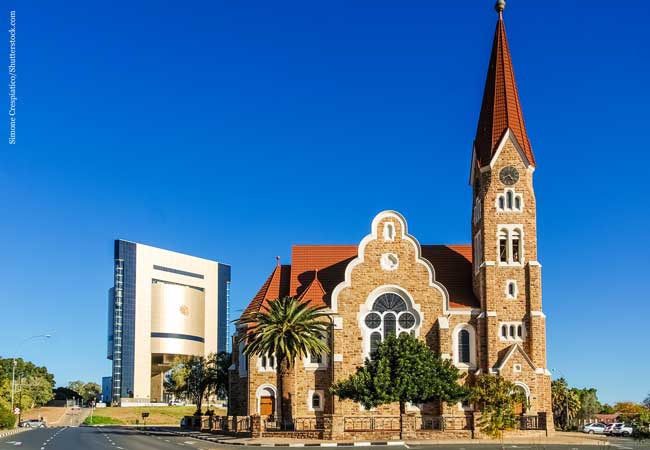The Senckenberg Natural History Museum features a special exhibition about paleoclimate research from 21 October 2022 until 16 July 2023.
How do natural scientists study the climate of the past? And how can this knowledge help us to better understand our climate future? These questions are addressed by the new special exhibition “Understanding Climate – Lessons from the Past” at the Senckenberg Natural History Museum, which opened today. Climate researchers from the Goethe University Frankfurt and the Senckenberg Gesellschaft für Naturforschung are joining forces in the VeWA* research consortium to search for traces in two geological eras, the Late Cretaceous and the Eocene, many millions of years ago. Both periods were characterized by high atmospheric CO2 levels and hot temperatures. The scientists’ goal is to reconstruct the climate processes of these past natural warm periods in order to predict future developments more precisely.
To this end, the researchers analyze so-called climate archives: fossilized remains of animals and plants or deposits in ice or rocks. They contain hidden information about the climate of the past. For example, the research team is examining the enamel of a prehistoric horse from the Messel Pit in Hesse or tiny calcareous algae only a few micrometers in size. The varying composition of chemical elements in these archives can provide information about the climatic conditions at that time.
The researchers use this approach to investigate the factors that influenced the climate: for example, the amount of greenhouse gases in the atmosphere, the ocean temperatures, or the distribution of plants on Earth. However, they cannot measure these values directly. Therefore, they determine proxy values, such as the concentrations of certain chemical elements or their isotopic composition in the climate archives. These data allow them to improve climate models. These models recreate the Earth’s climate system, using mathematical formulas to describe the processes and interactions of the atmosphere and land with the fauna and flora or the oceans.
“Looking into the past provides scientific insights that have also been incorporated into the report of the Intergovernmental Panel on Climate Change (IPCC),” emphasizes project initiator Prof. Dr. Wolfgang Müller of the Goethe University Frankfurt. “With the results of our paleoclimate research, we can test climate models that will help us assess our climate scenarios in the future – depending on how well we succeed in reducing global CO2 emissions,” he continues. “We are very grateful that the LOEWE program not only enables us to conduct our research, but also, and more importantly, to put on this exhibition dedicated to knowledge transfer. Here, we offer insights into our work processes and show how reliable climate knowledge is created,” says Müller.
“A research museum is the ideal place to share our findings from the cooperation between Goethe University and Senckenberg with the general public. It is particularly important for us to show how climate knowledge is created. Because it is clear that we need knowledge of climate history in order to be able to make smart decisions regarding climate developments today and tomorrow,” emphasizes Prof. Dr. Andreas Mulch, Director of the Senckenberg Research Institute and Natural History Museum Frankfurt.
The exhibition vividly illustrates the inner functions of scientific work – from the initial question to the research work and the scientific publication or, as is the case here, the communication of science by means of an exhibition that presents the results and models to society. The very design of the room with modules from an exhibition construction system already represents the international paleoclimate research network. “For us, the principle of sustainability was the first priority in developing the exhibition, next to the content – the architectural elements are on loan and will be returned once the exhibition is over. Practically all other materials used are recyclable,” emphasizes museum director Dr. Brigitte Franzen. “And the concept of sustainability also permeates the exhibition’s content and methodology,” she continues. “For the first time, an exhibition at our museum is an integral part of a research consortium. Here, we can curate while conducting research,” says Franzen.
“The room visually illustrates how all the steps in the research process are interconnected,” explains curator Lisa Voigt in regard to the room’s design. “The presentation of the scientific work is framed by the research network – a wall that introduces all project participants – and the question of how the knowledge reaches society,” she continues. The exhibition’s overarching questions are: What happens to the Earth system in the face of climate change; what role do humans play; and how do we move from knowledge to action? These issues are also reflected in the neighboring exhibition rooms showcasing mammals and reptiles.
Curator Dr. Andrea Weidt was particularly committed to showcasing the project’s individual researchers and their fields of research. “We want to bring science to life and take a peek over our researchers’ shoulders as they work in the field and in the lab,” says Weidt. “For example, when Michelle counts tiny calcareous algae under a microscope, Jorit, Romi, and Douglas dig for fossils on the coasts of England, and Julia creates computer simulations of past vegetation, they are all trying to decipher the climate of the past,” explains Weidt. In the exhibition, the researchers present their visions and their motivation to influence social and political decision-making processes, but they also talk about the highs and lows, the successes and frustrations in the everyday scientific work process.
New special exhibition “Understanding Climate – Lessons from the Past,” from 21 October 2022 to 16 July 2023 in the Senckenberg Natural History Museum Frankfurt, Senckenberganlage 25, D-60325 Frankfurt am Main. Combination tickets: 12 euros for adults, 6 euros for children and young adults (ages 6 to 15), and 30 euros for families (2 adults and up to 3 children). Opening hours: Mon, Tues, Thurs, Fri 9 a.m. – 5 p.m., Wed 9 a.m. – 8 p.m., Sat, Sun, and holidays 9 a.m. – 6 p.m.
*The VeWA research consortium – Past Warm Periods as Natural Analogues of our ‘High-CO2’ Climate Future – is a LOEWE priority project of the Hessian Ministry of Science and the Arts. Here, scientists from the Goethe University Frankfurt and the Senckenberg Gesellschaft für Naturforschung collaborate on studying the climate of past warm periods.
Prof. Dr. Wolfgang Müller and Prof. Dr. Silke Voigt from the Goethe University Frankfurt serve as project coordinators. Prof. Dr. Andreas Mulch is the contact person for the Senckenberg Gesellschaft für Naturforschung.
We thank the state of Hesse for the financial support. This exhibition is an essential part of the LOEWE priority project VeWA (Past Warm Periods as Natural Analogues of our “High-CO2” Climate Future), which is funded by the state of Hesse.
Source: senckenberg.de









